If you love preparing and eating fish, you’ll know the joy of seeing a fresh finned creature lying next to your cooker. Whether your outdoors next to a babbling brook or in the comfort of your own kitchen, you’ll need a sharp, flexible steel to get the cleanest cuts.
The best fillet knife will make cleaning and filleting a breeze, and with precision cutting so fine that you won’t lose any of the meaty bits.
As far as I’m concerned, you can’t beat the Rapala Fish n Fillet series. But if that’s not right for you, then I’ve also reviewed 5 more filleting knives as great alternatives.
Rapala Fish n Fillet Superflex Knife – Best Overall Fillet Knife
Specs
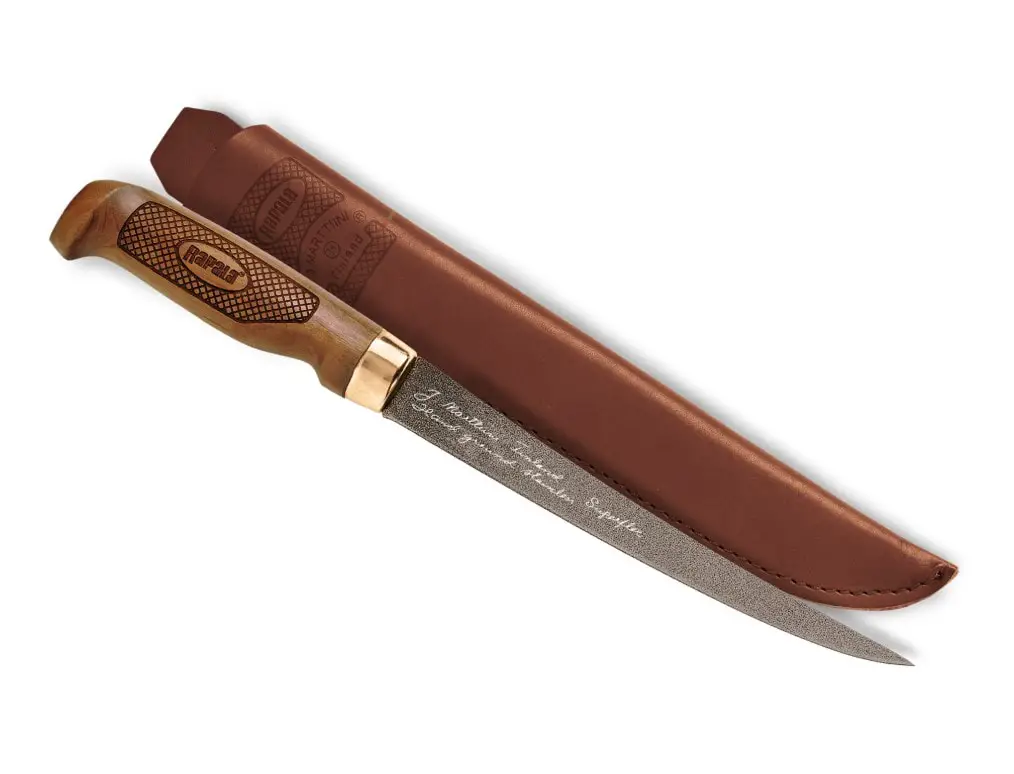
The Rapala Fish n Fillet Superflex Knife has a flexible blade of 6 inches, made from European stainless steel and is best for precision filleting.
It has a blade width of 11/16 inches and a thickness of 1/16 inches in the front and 10 3/4 inches in the back, weighing 4.8 ounces.
Note that it has a balanced full-tang blade, a birchwood handle and comes with a leather sheath.
The Verdict
As per its Superflex name, it’s extremely flexible and thin—designed to bend more than average to allow for a closer cut, so you don’t lose valuable meat when preparing for cooking.
Another helpful feature for slicing your fish is the PTFE non-stick coating that prevents the fillets from sticking to the blade, allowing the knife to slide easily through the meat.
It has an incredibly sharp edge, which is great for close, clean cutting, but you’ll need to be careful handling it. Included is a single-stage sharpener so that you can maintain the blade’s sharp edge.
The full-tang, tapered blade on this knife is made from long-lasting European stainless steel, while the handle’s handcrafted birch wood is of medium hardness and is quite durable when used in this context. The wood design is finished with a polished brass ferrule, giving it a classy look in addition to its practicality.
This flexible knife’s quality is high enough that it can withstand use in fresh and seawater, and the stainless steel blade is non-corrosive.
To keep your blade safe while fishing, it comes with a leather sheath that protects it from the elements. The sheath also attaches to your belt with a loop, so it’s always within easy reach.
The crafted wooden handle makes it unsuitable for dishwasher cleaning, but that’s the only downside this knife has.
In Summary
I’ve selected the Superflex knife as my best fillet knife overall. Although it’s manufactured in Finland, it’s become one of America’s favorite utensils. The extremely sharp blade flexes easily without breaking, which allows for a more precise cut so that no meat goes to waste.
Dalstrong Fillet Knife Shogun Series – Best for Kitchen
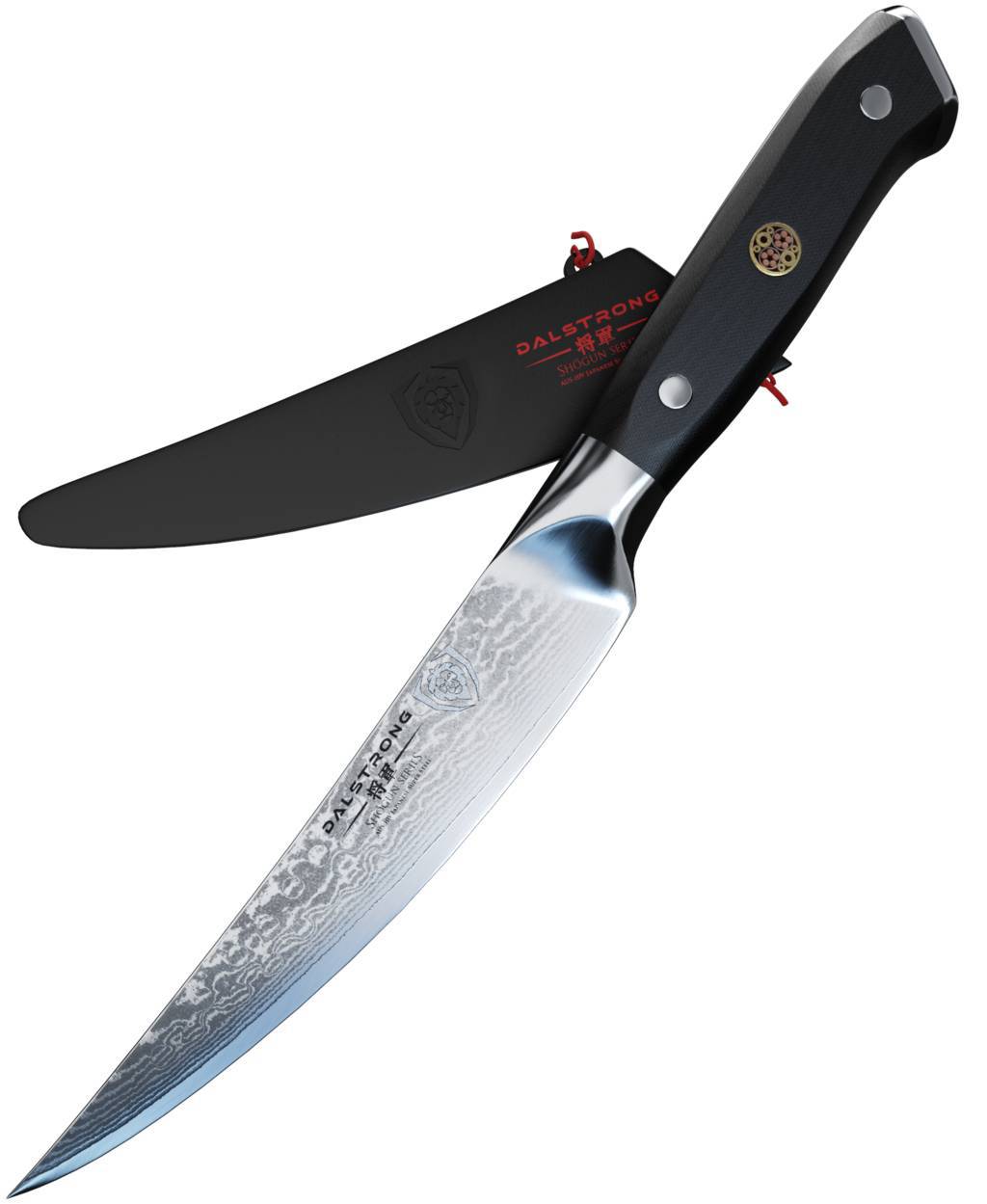
Specs
The Dalstrong Fillet Knife Shogun Series is made from Japanese steel and weighs only 6.4 ounces, due in part to the blade thickness of 0.07 inches. The blade also features an 8 to 12-degree double bevel and a G-10 handle, which is made from fiberglass resin.
It’s best suited to kitchen use due to its scalpel-like blade and heat-, cold-, and moisture-resistant handle.
The Verdict
Despite this blade consisting of 66 layers of superior high-carbon stainless steel, it’s only 0.07 inches thick. This makes it thinner than the usual Shogun standard—0.09 inches—but doesn’t sacrifice any strength. For this, the cryogenic liquid nitrogen tempering enhances the strength of the blade without compromising on flexibility.
As well as having a supremely thin spine, the blade has an 8 to 12-degree angle on either side, creating a scalpel-like edge. That, and the fact that the tempered blade adds a non-stick element to it—although there’s no coating on this knife—makes it a great addition to the kitchen.
As with most Shogun products, the design of this knife is great for use in the kitchen. The blade is moderately flexible and comes to a narrow point, which is helpful for cutting around bones and under skin with little effort.
It has a full-tang for through-and-through strength, with a flexible tapered blade that’s balanced to provide a more comfortable user experience.
Another comfort-oriented feature, and the finishing touch on this knife, is a triple-riveted handle, which is hand-polished and ergonomically shaped for high comfort levels. The handle is constructed of thermoset laminate G-10, making it resistant to heat, cold and moisture.
The blade is also hand-polished, creating a striking pattern that adds an artsy feel to this knife. It’s perfect for chefs who value presentation as well as quality.
In Summary
Shogun creates their knives by combining the latest technology with ancient Japanese sword-making techniques. The quality, strength, flexibility, and good looks of this knife make it my choice as the best fillet knife for the kitchen.
KastKing Fillet Knife – Best Budget Fillet Knife
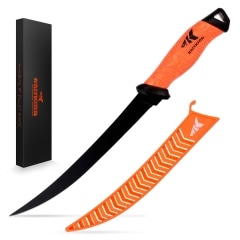
Specs
The KastKing Fillet Knife is 9.3 ounces in weight with a 9-inch blade that sports a matte black finish and is made of G4116 German stainless steel. The handle has a non-slip super polymer grip.
Its stiffness and slightly thicker design make it a great option for filleting bigger fish, such as salmon or tuna.
The Verdict
The KastKing takes the top spot for the best budget knife. It has a thicker blade that’s made from G4116 German stainless steel and is stiffer than most fillet knives, but still has some flexibility.
It’s a hardcore, sporty-looking knife that cuts just as effectively in a freshwater or saltwater environment.
I also like that the non-slip, super polymer grip handle means that whether you’re in the water or prepping food at the kitchen table, your grip will be solid.
The stainless steel blade is corrosion-resistant and is finished with a smart, eye-catching black finish. To protect the matte finish, it comes with a specially-made sheath that hugs the blade.
This sheath has a unique, lockable design that adds an element of safety but is easily removed, so the knife is within your grasp at all times. It also has an open, slotted construction, allowing for water to run through it—this prevents the knife from sitting in liquid and compromising the integrity of the blade.
In Summary
This smart-casual knife is great if you’re looking for something versatile and affordable. It performs equally well in salt and freshwater environments, and its uses include filleting and deboning fish and other meat. You’ll get high quality for a reasonable price.
Outdoor Edge – Best Folding Fillet Knife
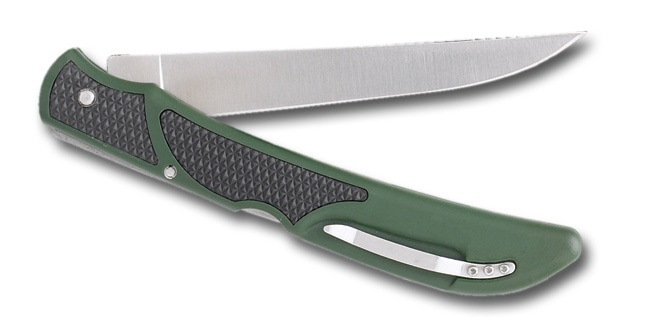
Specs
Outdoor Edge’s fillet knife is 11.3 inches when unfolded but has a 5-inch, double-tempered 440A stainless steel blade while only weighing 3.5 ounces.
It also has a double-molded Zytel handle with non-slip TPR rubber inserts, and the purchase includes a nylon sheath.
It’s designed for on-the-go use while you’re out in the bush getting ready to cook the caught dinner, but works better for smaller fish.
The Verdict
This is an adventure knife through and through since the compact size slips easily into a pocket or backpack.
The double-tempered, 440A stainless steel blade is durable, and the handle with non-slip TPR rubber inserts provides a better grip for added safety. Also, the small nylon sheath protects the blade and is easy to clip onto a belt or pocket, so your knife is right where you need it.
This folding knife’s features are perfect for the outdoors, so feel free to use it while freshwater or sea fishing. Note that the blade shouldn’t rust in water—fresh or salt—but the belt clip might.
You have a couple of color options, too: if you want a camouflage option, go for the green. If you like a bit of color, choose the orange.
While the compact size of this knife earns a thumbs-up in terms of portability and ease of carrying, it may not be the best for filleting large fish. It’s certainly sharp enough to do the job, but the shorter blade would mean it would take longer than average. Fantastic for trout, not so easy for halibut.
In Summary
Our best folding fillet knife is perfect for the outdoorsman—or woman. Made to handle anything you can throw at it, this sharp, double-tempered knife is great for seawater, freshwater and on land.
Buck Knives Silver Creek – Best Fillet Knife For Big Fish
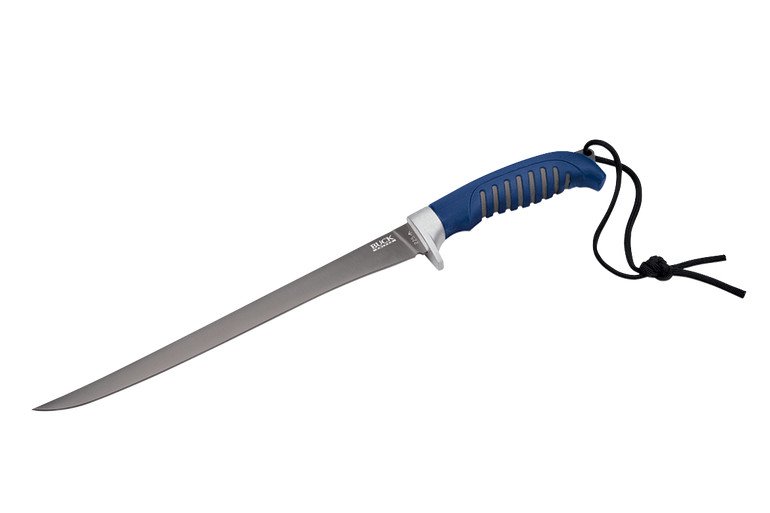
Specs
This Buck knife is 14 ⅜ inches in length and weighs 5.3 ounces, with a 9 ⅝ inch titanium-coated blade. Additionally, the blade is 420J2 stainless steel and has a glass-reinforced handle constructed from polypropylene with a rubber coating.
Due to the blade length, I feel this knife is best for big fish.
Note: This knife comes in two blade lengths 6 ⅜ and 9 ⅝ inches.
The Verdict
With a choice of two different blade lengths, this sharp, easy-to-carry knife is my best knife for filleting large fish. The titanium-coated, stainless steel blade is corrosion-resistant, so you can use it anywhere without worrying about damage.
The handle has an ergonomic TPE rubber coating for a comfortable in-hand fit and a better grip while in action, which adds an extra safety factor. This combines well with the stainless steel guard, which has a protective element as well as a stylish look.
Buck uses Paul Bos’ heat treatment on its knives, which strengthens and sharpens them. Because of this special treatment, Buck’s knives have a reputation of being incredibly sharp out of the box and remain sharper for longer—according to the manufacturer.
The sheath is injection-molded and features a belt clip and drainage holes. The knife itself has a lanyard hole, so it’s easy to attach to a pocket or bag and not have to worry about carrying it.
In Summary
Whichever size you choose, this is our best fillet knife for filleting large fish. If your fish of choice is a big one, this non-corroding, titanium-coated, extra-sharp knife will do the job well.
Rhinoreto Fish Fillet Knife – Best Non-Stick
Specs
Rhinoreto Fish Fillet knife is a full-tang blade that’s made from stainless steel. The blade has a non-stick coating and comes with a rubber handle.
The various sizes make it great for filleting any size fish, and the non-stick blade and rubber handle makes it very safe and great for kitchen use.
Note: Available sizes are: 5, 6.5 and 8 inches. The 8-inch knife weighs 7.2 ounces; the 6.5-inch knife weighs 6.7 ounces while the 5-inch knife weighs 6.4 ounces.
The Verdict
This Rhinoreto knife features a thin, extremely pointy blade that makes filleting easy. It’s fairly flexible and coated with non-stick material, which gives it a sleek look and helps it glide through fish like they’re melted butter.
It features an ambidextrous handle that’s non-slip rubber, making every filleting experience as safe as possible. Added to this, a 360-degree guard brings an extra element of safety and security.
The knife comes with a lightweight, vented sheath to keep it safe while in storage or traveling. It also allows water to run off and not pool in the sheath while stored, effectively reducing odors.
You’ll also get a blade sharpener with your purchase, which is easy to use and ensures your knives will be around for many years to come. Rhinoreto suggests hand-washing to keep your knife in prime condition.
In Summary
The Rhinoreto takes the top spot for the best non-stick fillet knife. Between its non-stick coating, flexibility and attractive finish, it would work equally well in a kitchen as it would outdoors.
Choosing the Best Fillet Knife
You need a fillet knife that’s thin, flexible and easy to maneuver across the skin so that you can get the most flesh from your catch. To get the most out of your fillet knife, take the following into consideration:
- Blade.
- Handle.
- Size.
- Sheath.
Blade
The best fillet knife should have a blade made from corrosion-resistant metal, such as stainless steel, especially if you spend a lot of time in saltwater. This will ensure it lasts a long time and doesn’t rust.
Another feature to ensure a durable knife is a full-tang blade—steel running all the way through the handle—as this will make the blade stronger and won’t break if you’re cutting through a tougher fish.
As well as being long-lasting, you’ll want a thin blade that has a sharp edge. It should also have a good amount of flexibility, as this will help you follow the curvature of the bones.
Smaller fish will require sharper cuts and will have tighter angles, so a knife with a shorter blade would have more flex and make slicing through the fish easier. If you’re likely to be cutting through larger fish, a longer blade would be better.
Handle
Don’t underestimate the importance of the handle of your knife. The handle provides leverage, and it needs to have a good grip to keep you safe and comfortable while cutting. There are a variety of handles to choose from:
- Rubber.
- Wood.
- Plastic.
Rubber and plastic are both good options as they’re durable materials, and you won’t have to worry about corrosion. Your hands are going to be wet and covered in fish, so pick a non-slip handle with a firm grip. A comfortable, ergonomic grip will also make slicing through the fish quicker.
You’re really looking for a handle that provides easy maneuvering and great traction—rubber provides the best grip overall.
Choosing a handle will come down to your personal preference and what feels right in your hand.
Size
Depending on what you’re going to be fishing for, you may be better off with a larger or smaller blade:
- Small fish: A blade smaller than 7 inches is great for bluegill, perch, crappie and similar-sized fish.
- Medium fish: A blade of around 7 inches is right in the zone for fish such as bass and trout.
- Large fish: Knives with a blade longer than 7 inches are well-suited to large fish like salmon and tuna.
- All-round option: You could always choose two different types of fillet knives that cover all bases. If you don’t want to buy separate knives, a 7.5-inch blade works for small to medium fish as a more all-round knife.
Sheath
Often overlooked, sheaths play a large part in keeping your blade in good condition. They’re also there to protect the knife’s blade—and you—when not in use. Fillet knives are extremely sharp, and you’ll want to avoid any accidental knicks.
They can come in a variety of materials, with nylon and plastic being the most common:
- Nylon: Tear-resistant and fast-drying. Some people prefer this as they find it’s easy to maintain.
- Plastic: Most plastic sheaths come with draining ports and ventilation that aids in drying the blade.
Sharpening
Your fillet knife is going to require maintenance over its lifetime to keep the blade sharp. If your knife is blunt or not doing its job as well as it used to, it’s advisable that you use a sharpening stone to sharpen the blade. Once that’s done, use the pocket sharpener that came with your fillet knife to fine-tune the edge of the knife.
It’s important to remember that your fillet knife wasn’t designed to pry something open or to cut the bait line. Actions like this can damage the knife, and even fish-related actions, such as cutting through scales and skin, can make your knife blunt.
It would be better to use a serrated knife to make your initial cuts and then use your fillet knife only for its intended purpose. This will save the edge of your knife.
Have a look at the instructions that came with your knife to find out how to sharpen it. The method may vary depending on the blade’s material. If your knife has a carbon steel blade, it’ll be easier to sharpen than other materials.
FAQs
What Size Fish Fillet Knife Is Best?
The best size for a fish fillet knife depends on the fish you’ll be filleting.
If you’re catching fluke, cod or bluefish, a 9-inch blade would be the perfect length. The extra length on the blade will come in handy when you’re slicing your fillets to avoid wasting any fish.
A fillet blade of 6-inches would work very well on trout, bluegill or rock bass. With the thin blade and flexibility, you would remove all meat from the bones easily.
What Is the Best Steel for a Fillet Knife?
The best steel for a fillet knife is high carbon stainless steel as it has a higher breaking point. A blade made from high carbon stainless steel would be able to cut through frozen meat.
High-carbon stainless steel is a metal alloy that can contain up to 1.2% of carbon. It also contains chromium, which is what makes stainless steel stain-resistant.
Due to these properties, knife companies prefer high-carbon stainless steel over other materials as it makes their blades extremely hard and long-lasting. It’s able to maintain an extremely sharp edge, which also means less maintenance.
Although high carbon stainless steel is harder than stainless steel, it’s also easier to sharpen than stainless steel.
What Kind of Knife Do You Use to Fillet a Fish?
Use a specialized fillet knife to fillet a fish. They’re specifically designed with thin and flexible blades that allow you to cut the fillet down to the fish’s bones. Although you could use a normal knife, using a fillet knife will allow you to get the closest cut and not waste meat.
Fillet knives come in a variety of shapes, sizes and materials. When shopping for the best fillet knife, consider the type of fishing you’re doing, as this will determine the best knife for you.
Conclusion
Having the best fillet knife in your arsenal can make your fishing, cutting, and cooking experience much easier and quicker.
Our choice for the best fillet knife is the Rapala Fish n Fillet Superflex Knife. It’s extremely flexible, has a strong full-tang blade and a non-stick coating to make cutting easy.
The runner-up choice is Dalstrong Fillet Knife Shogun Series. It’s incredibly thin but strengthened by cryogenic liquid nitrogen and has a handle that is resistant to cold, heat and moisture.
Choosing the best fillet knife for you depends on the size of the fish you’re going to be fishing for. However, it never hurts to have more than one, so if you want to go after a somewhat larger fish, you know you’re covered.






